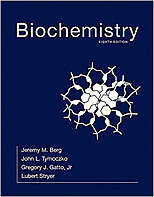
Biochemistry
Berg, Jeremy M.; Tymoczko, John L.; Gatto, Jr., Gregory J.; Stryer, Lubert
8 ed.
New York: W.H. Freeman and Company, 2015
 |
Biochemistry Berg, Jeremy M.; Tymoczko, John L.; Gatto, Jr., Gregory J.; Stryer, Lubert 8 ed. New York: W.H. Freeman and Company, 2015 |
104 termes
| P site n. |
|
| p160 family n. |
|
| P680 n. |
|
| P700 n. |
|
| P960 n. |
|
| PABPI n. (poly(A) tail-binding protein I) |
|
| paddle n. |
|
| pancreatic failure n. |
|
| PAP n. (phosphatidic acid phosphatase) |
|
| Paracoccus denitrificans [nom cientÝfic] |
|
| parallel |
|
| passenger strand n. |
|
| pathway integration n. |
|
| PCSK9 n. (proprotein convertase subtilisin/kexin type) |
|
| PDK n. (pyruvate dehydrogenase kinase) |
|
| PDK n. (phosphatidylinositol-dependent protein kinase) |
|
| PDP n. (pyruvate dehydrogenase phosphatase) |
|
| Penicillium citrinum [nom cientÝfic] |
|
| penicilloyl-enzyme derivative n. |
|
| pentose shunt n. |
|
| peptide hydrolysis n. |
|
| peptide mass fingerprinting n. |
|
| peptide sequence n. |
|
| peptide sequencing n. |
|
| peptide-cleaving enzyme n. |
|
| peptide-ligation method n. |
|
| periplasmic side n. |
|
| PEST sequence n. |
|
| phosphate carrier n. |
|
| phosphatidic acid phosphatase n. (PAP) |
|
| phosphatidylinositol 3,4,5-trisphosphate n. (PIP3) |
|
| phosphatidylinositol-dependent protein kinase n. (PDK) |
|
| phosphodiester-bridge n. |
|
| phospholipid synthesis n. |
|
| phosphopantetheine n. |
|
| phosphorolytic cleavage n. |
|
| phosphoryl transfer n. |
|
| phosphorylated compound n. |
|
| phosphoryl-transfer potential n. |
|
| photosynthetic reaction center n. |
|
| photosynthetic system n. |
|
| p-hydroxyphenylpyruvate n. |
|
| p-hydroxyphenylpyruvate hydroxylase n. |
|
| physiological role n. |
|
| PIC n. (43S preinitiation complex ) |
|
| Pichia pastoris [nom cientÝfic] |
|
| PIP2 n. |
|
| PIP3 n. (phosphatidylinositol 3,4,5-trisphosphate) |
|
| pKa value n. |
|
| planar bilayer membrane n. |
|
| plasma-membrane protein n. |
|
| pleckstrin homology domain n. |
|
| P-loop structure n. |
|
| PLP-Schiff-base linkage n. |
|
| PMP n. (pyridoxamine phosphate) |
|
| pointed end n. |
|
| polar amino acid n. |
|
| polarity scale n. |
|
| poly(A) tail-binding protein I n. (PABPI) |
|
| polylinker region n. |
|
| polymeric structure n. |
|
| positively charged amino acid n. |
|
| posttranslational modification n. |
|
| PP1 n. (protein phosphatase 1) |
|
| PP2A n. |
|
| prephenate branch n. |
|
| pre-rRNA n. |
|
| primary active transport n. |
|
| primary antibody n. |
|
| procaspase n. |
|
| prokaryotic polymerase n. |
|
| prolyl hydroxylase 2 n. |
|
| pro-N-terminal degron n. |
|
| proprotein convertase subtilisin/kexin type n. (PCSK9) |
|
| prostacyclin synthase n. |
|
| prostaglandin H2 n. |
|
| prostaglandin H2 synthase-1 n. |
|
| protective effect n. |
|
| protective function n. |
|
| protein aggregate n. |
|
| protein colipase n. |
|
| protein kinase cascade n. |
|
| proteomic method n. |
|
| proton path n. |
|
| proton-conducting unit n. |
|
| proviral DNA n. |
|
| pro-vitamin D3 n. (7-dehydrocholesterol) |
|
| pseudosubstrate sequence n. |
|
| pumping n. |
|
| pure hemoglobin n. |
|
| pure protein n. |
|
| purified hemoglobin n. |
|
| purine biosynthetic pathway n. |
|
| purine catabolism n. |
|
| purine synthesis n. |
|
| purinosome n. |
|
| pyrimidine biosynthesis n. |
|
| pyrimidine biosynthetic pathway n. |
|
| pyrosequencing n. |
|
| pyrrolidine ring n. |
|
| pyruvate dehydrogenase n. |
|
| pyruvate dehydrogenase kinase n. (PDK) |
|
| pyruvate dehydrogenase phosphatase n. (PDP) |
|
| pyruvate kinase M n. |
|